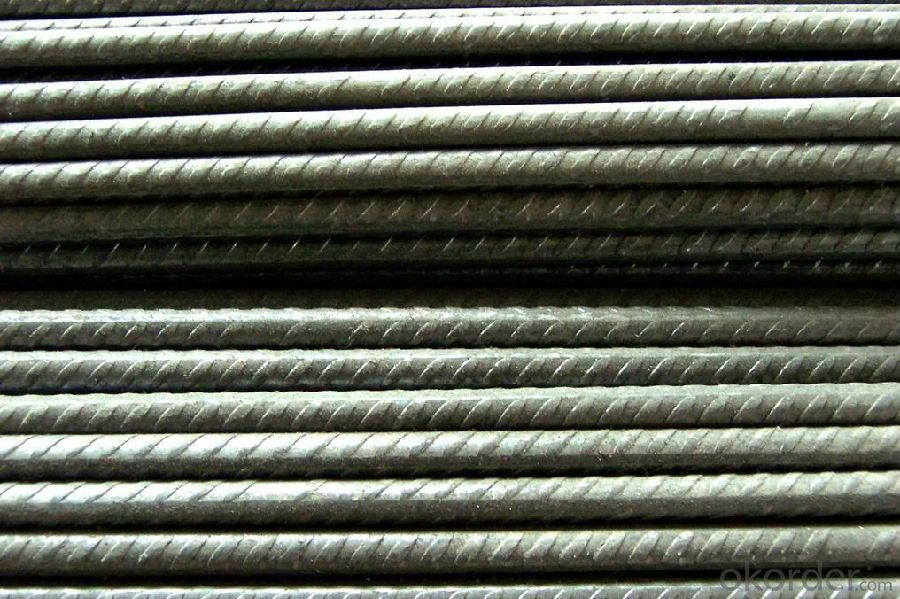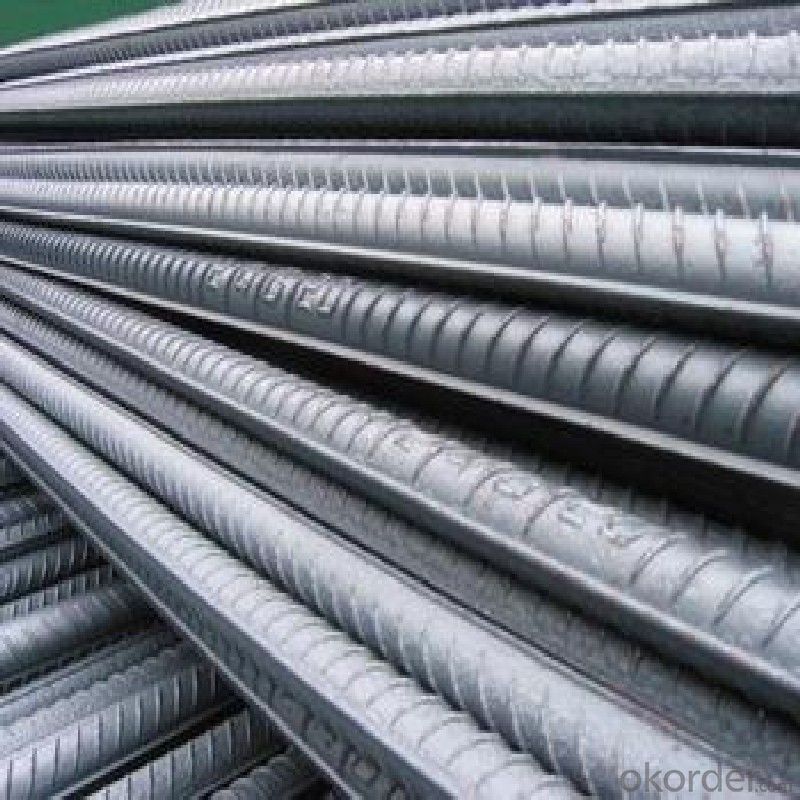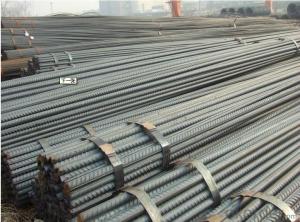Deformed Bar Hot Rolled High Quality BS4449
- Loading Port:
- Tianjin
- Payment Terms:
- TT OR LC
- Min Order Qty:
- 25 m.t.
- Supply Capability:
- 20000000 m.t./month
OKorder Service Pledge
OKorder Financial Service
You Might Also Like
Item specifice
Product Description:
OKorder is offering high quality Hot Rolled Steel I-Beams at great prices with worldwide shipping. Our supplier is a world-class manufacturer of steel, with our products utilized the world over. OKorder annually supplies products to European, North American and Asian markets. We provide quotations within 24 hours of receiving an inquiry and guarantee competitive prices.
Product Applications:
Deformed bar is widely used in buildings, bridges, roads and other engineering construction. Big to highways, railways, bridges, culverts, tunnels, public facilities such as flood control, dam, small to housing construction, beam, column, wall and the foundation of the plate, deformed bar is an integral structure material. With the development of world economy and the vigorous development of infrastructure construction, real estate, the demand for deformed bar will be larger and larger
Product Advantages:
OKorder's Steel I-Beams are durable, strong, and resist corrosion, exact size, regular package, chemical and mechanical properties are stable.
Main Product Features:
· Premium quality
· Prompt delivery & seaworthy packing (30 days after receiving deposit)
· Corrosion resistance
· Can be recycled and reused
· Mill test certification
· Professional Service
· Competitive pricing
Product Specifications:
Manufacture: Hot rolled
Grade: BS4449
Certificates: ISO, SGS, BV, CIQ
Diameter: 6mm,8mm,10mm,12mm,14mm,16mm,18mm,20mm,
22mm,25mm,28mm,32mm,36mm,40mm,50mm
Length: 6M, 9M,12M or as required
Packaging: Export packing, nude packing, bundled
Chemical Composition: (Please kindly find our chemistry of our material based on HRB500 as below for your information)
Grade | Technical data of the original chemical composition (%) | ||||||
C | Mn | Si | S | P | V | ||
HRB400 | ≤0.25 | ≤1.60 | ≤0.80 | ≤0.045 | ≤0.045 | 0.04-0.12 | |
Physical capability | |||||||
Yield Strength (N/cm²) | Tensile Strength (N/cm²) | Elongation (%) | |||||
≥400 | ≥570 | ≥14 | |||||
Theoretical weight and section area of each diameter as below for your information:
Diameter(mm) | Section area (mm²) | Mass(kg/m) | Weight of 12m bar(kg) |
6 | 28.27 | 0.222 | 2.664 |
8 | 50.27 | 0.395 | 4.74 |
10 | 78.54 | 0.617 | 7.404 |
12 | 113.1 | 0.888 | 10.656 |
14 | 153.9 | 1.21 | 14.52 |
16 | 201.1 | 1.58 | 18.96 |
18 | 254.5 | 2.00 | 24 |
20 | 314.2 | 2.47 | 29.64 |
22 | 380.1 | 2.98 | 35.76 |
25 | 490.9 | 3.85 | 46.2 |
28 | 615.8 | 4.83 | 57.96 |
32 | 804.2 | 6.31 | 75.72 |
36 | 1018 | 7.99 | 98.88 |
40 | 1257 | 9.87 | 118.44 |
50 | 1964 | 15.42 | 185.04 |
FAQ:
Q1: Why buy Materials & Equipment from OKorder.com?
A1: All products offered byOKorder.com are carefully selected from China's most reliable manufacturing enterprises. Through its ISO certifications, OKorder.com adheres to the highest standards and a commitment to supply chain safety and customer satisfaction.
Q2: How do we guarantee the quality of our products?
A2: We have established an advanced quality management system which conducts strict quality tests at every step, from raw materials to the final product. At the same time, we provide extensive follow-up service assurances as required.
Q3: How soon can we receive the product after purchase?
A3: Within three days of placing an order, we will begin production. The specific shipping date is dependent upon international and government factors, but is typically 7 to 10 workdays.


- Q:Can steel rebars be used in the construction of pedestrian bridges and walkways?
- Yes, steel rebars can be used in the construction of pedestrian bridges and walkways. Steel rebars provide strength, durability, and flexibility, making them an ideal choice for reinforcing concrete structures. They enhance the load-bearing capacity of the bridge or walkway, ensuring its safety and longevity.
- Q:What is the role of steel rebars in reducing concrete creep?
- Steel rebars play a crucial role in reducing concrete creep. Concrete creep refers to the gradual deformation or movement of concrete over time under sustained loading. This phenomenon occurs due to the long-term effects of stress and environmental factors on the concrete structure. By incorporating steel rebars into concrete structures, the creep behavior of concrete is significantly reduced. Steel rebars are high-strength reinforcement bars that are embedded within the concrete to enhance its structural integrity and durability. They provide tensile strength to counteract the tensile stresses that can cause concrete to creep. When concrete is subjected to sustained loads, such as the weight of a building or a bridge, it experiences internal stresses that can lead to creep. However, the presence of steel rebars helps to distribute these stresses more evenly throughout the structure. The rebars act as a reinforcement, absorbing and redistributing the tensile forces, thus minimizing the deformation of the concrete. Additionally, steel rebars also improve the bond between concrete and the reinforcement. This bond is essential for transferring the tensile forces from the concrete to the rebars and ensuring that they work together as a composite material. The strong bond between concrete and rebars prevents the formation of cracks, which can further contribute to creep. Furthermore, steel rebars also enhance the overall stiffness and rigidity of the concrete structure. This increased stiffness helps to resist the deformation caused by creep, maintaining the integrity and stability of the structure over time. In summary, the role of steel rebars in reducing concrete creep is vital. They provide tensile strength, distribute internal stresses, improve the bond between concrete and reinforcement, and enhance the overall stiffness of the structure. By incorporating steel rebars, engineers can effectively mitigate the effects of creep and ensure the long-term performance and durability of concrete structures.
- Q:Can steel rebars be used in structures with high moisture content in the environment?
- No, steel rebars should not be used in structures with high moisture content in the environment as it can lead to corrosion and weakening of the rebars, compromising the structural integrity of the building.
- Q:What are the common manufacturing processes for steel rebars?
- The common manufacturing processes for steel rebars include hot rolling, cold rolling, and thermomechanical treatment.
- Q:Can steel rebars be used in reinforced concrete structures?
- Yes, steel rebars can be used in reinforced concrete structures.
- Q:Can steel rebars be used in energy-efficient buildings?
- Yes, steel rebars can be used in energy-efficient buildings. Steel rebars are commonly used in the construction of reinforced concrete structures, including energy-efficient buildings. Energy-efficient buildings focus on reducing energy consumption and minimizing environmental impact. While steel is a material with high embodied energy, meaning it requires a significant amount of energy for its production, it offers several advantages for energy-efficient buildings. Firstly, steel rebars provide structural strength to reinforced concrete, allowing for the construction of durable and long-lasting buildings. This is crucial for energy-efficient buildings as they are designed to have a longer lifespan and lower maintenance requirements, reducing the overall environmental impact. Additionally, steel rebars can be used in the construction of energy-efficient building components such as insulated concrete forms (ICFs) and precast concrete panels. These building systems offer excellent thermal insulation properties, reducing heat transfer and improving energy efficiency. Steel rebars are used to reinforce these components, ensuring their structural integrity. Furthermore, the thermal mass properties of concrete, reinforced by steel rebars, can contribute to the energy efficiency of a building. Concrete absorbs and stores heat, helping to regulate indoor temperatures and reduce the need for excessive heating or cooling. This can result in significant energy savings over the lifespan of a building. It is important to note that the energy efficiency of a building depends on various factors, including insulation, window design, HVAC systems, and renewable energy integration. While steel rebars are an integral part of reinforced concrete structures, their impact on the overall energy efficiency should be considered in conjunction with other design choices and building materials.
- Q:Can steel rebars be used in structures with limited construction budget?
- Yes, steel rebars can be used in structures with limited construction budget. Steel rebars are commonly used for reinforcement in concrete structures due to their affordability and high strength. They provide structural integrity and enhance the overall durability of the construction. Therefore, using steel rebars in structures with limited budget can be a cost-effective option without compromising the safety and stability of the building.
- Q:Can steel rebars be used in energy-efficient buildings?
- Certainly! Energy-efficient buildings can indeed incorporate steel rebars. These rebars are commonly utilized in the construction of reinforced concrete structures, including those that prioritize energy efficiency. Energy-efficient buildings aim to decrease energy consumption and minimize their environmental footprint. Although steel is a material with high embodied energy, meaning it requires a substantial amount of energy for production, it boasts numerous advantages for energy-efficient buildings. To begin with, steel rebars lend structural strength to reinforced concrete, enabling the creation of robust and long-lasting structures. This is pivotal for energy-efficient buildings, as their goal is to have an extended lifespan and reduced maintenance requirements, thereby lessening their overall environmental impact. Additionally, steel rebars can be employed in the construction of energy-efficient building components, such as insulated concrete forms (ICFs) and precast concrete panels. These building systems possess exceptional thermal insulation properties, which decrease heat transfer and enhance energy efficiency. Steel rebars are utilized to reinforce these components, ensuring their structural integrity. Furthermore, the thermal mass characteristics of concrete, reinforced by steel rebars, can contribute to a building's energy efficiency. Concrete has the capability to absorb and store heat, aiding in the regulation of indoor temperatures and reducing the need for excessive heating or cooling. Consequently, this can result in significant energy savings throughout a building's lifespan. It is important to note that the energy efficiency of a building is contingent upon various factors, including insulation, window design, HVAC systems, and the integration of renewable energy. While steel rebars play a vital role in reinforced concrete structures, their impact on overall energy efficiency should be evaluated in conjunction with other design choices and building materials.
- Q:How do steel rebars contribute to the strength of concrete structures?
- Steel rebars contribute to the strength of concrete structures by providing reinforcement and increasing their durability. When embedded within concrete, rebars absorb tension forces that concrete alone cannot withstand, preventing cracking and improving the overall structural integrity. This combination of steel and concrete creates a composite material that can withstand greater loads and stresses, making it suitable for constructing buildings, bridges, and other infrastructure that require strength and stability.
- Q:What is the process of joining steel rebars together?
- The process of joining steel rebars together is commonly done through methods such as overlap splicing, mechanical splicing, and welding. In overlap splicing, two rebars are overlapped and tied together using wire or steel straps. Mechanical splicing involves using couplers or threaded connectors to join rebars together. Welding, on the other hand, involves melting the ends of two rebars and fusing them together using heat. Each method has its own advantages and considerations, depending on factors like the structural requirements and project specifications.
1. Manufacturer Overview |
|
|---|---|
| Location | |
| Year Established | |
| Annual Output Value | |
| Main Markets | |
| Company Certifications | |
2. Manufacturer Certificates |
|
|---|---|
| a) Certification Name | |
| Range | |
| Reference | |
| Validity Period | |
3. Manufacturer Capability |
|
|---|---|
| a)Trade Capacity | |
| Nearest Port | |
| Export Percentage | |
| No.of Employees in Trade Department | |
| Language Spoken: | |
| b)Factory Information | |
| Factory Size: | |
| No. of Production Lines | |
| Contract Manufacturing | |
| Product Price Range | |
Send your message to us
Deformed Bar Hot Rolled High Quality BS4449
- Loading Port:
- Tianjin
- Payment Terms:
- TT OR LC
- Min Order Qty:
- 25 m.t.
- Supply Capability:
- 20000000 m.t./month
OKorder Service Pledge
OKorder Financial Service
Similar products
New products
Hot products
Related keywords




























